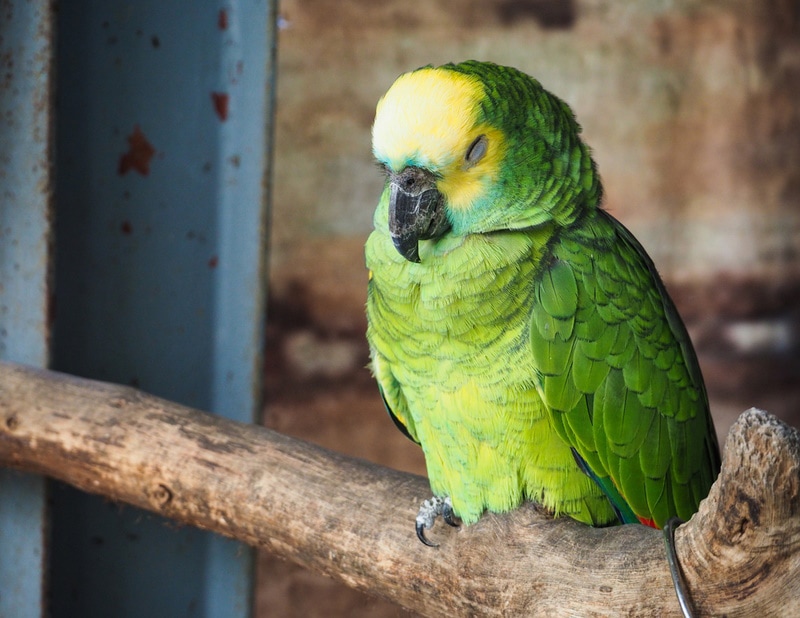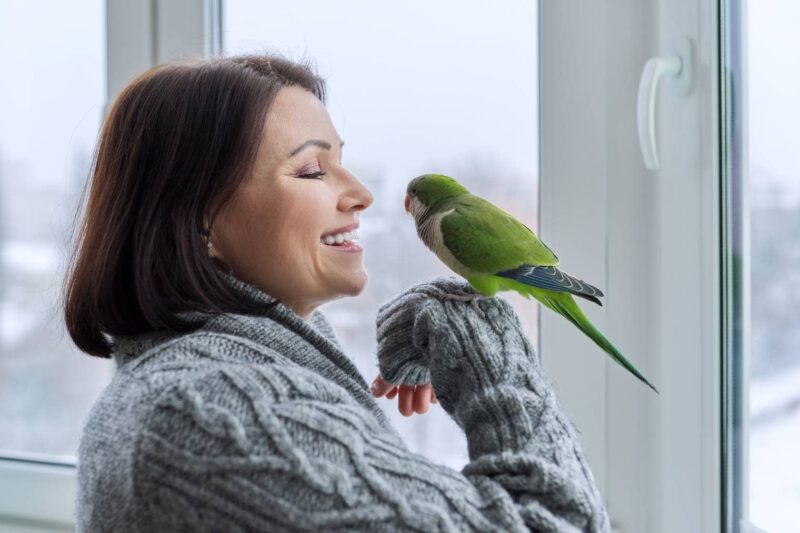7 Small Pet Birds That You Can Easily Keep at Home!
Updated on
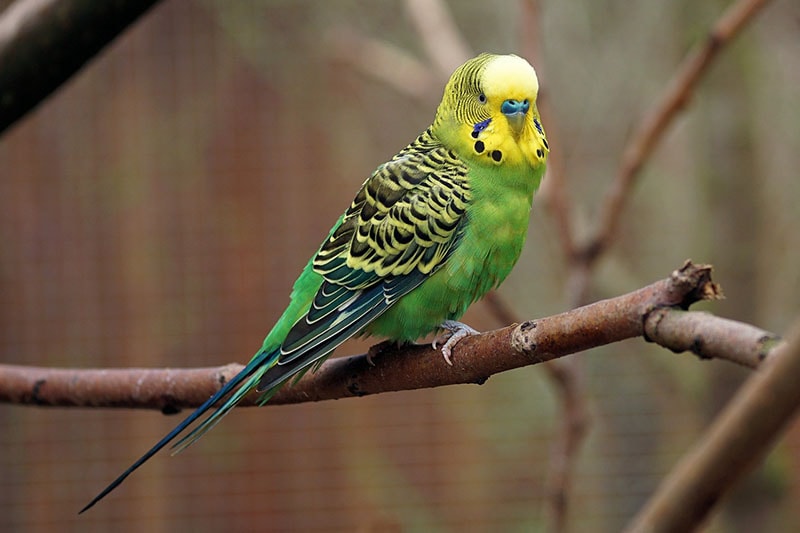
Birds are unique, interesting pets. Smaller birds are generally easier to keep, often making them a more popular option than larger parrots.
There are tons of different small birds out there that are domesticated and many of these have different characteristics and care requirements. Therefore, it’s essential to carefully research any bird species before adopting one and bringing it home. You may be surprised by how different some of these species are, which makes them suitable for completely different situations.
Here is a list of the most popular small birds you can keep as pets, as well as a little bit of information about each species:
Top 7 Small Pet Birds Best Suited for Your Home
1. Canaries

| Lifespan: | 5–10 years |
| Diet: | Seeds, grains, fruits, and veggies |
Canaries are smaller birds from the finch family. They’re native to the Canary Islands, hence their name. However, they were brought to Europe in the 16th century.
These birds are best known for their extreme singing abilities. They sing in the wild to attract mates and establish territory. However, they’ve been specifically bred for their singing ability, which has led to their singing becoming even more beautiful. There are different canary breeds that have slightly different songs, largely due to careful breeding.
These birds are relatively small, though males are slightly larger than females. They come in many different colors, with different breeds exhibiting different patterns. Canaries require a diet comprising of grains, seeds, fruits, and vegetables. They also need a source of calcium to keep their bones strong, such as eggshells or cuttlebone.
Despite their smaller size, they require a relatively spacious cage with plenty of activities. They’re active birds, which is why they require so much room.
2. Finches
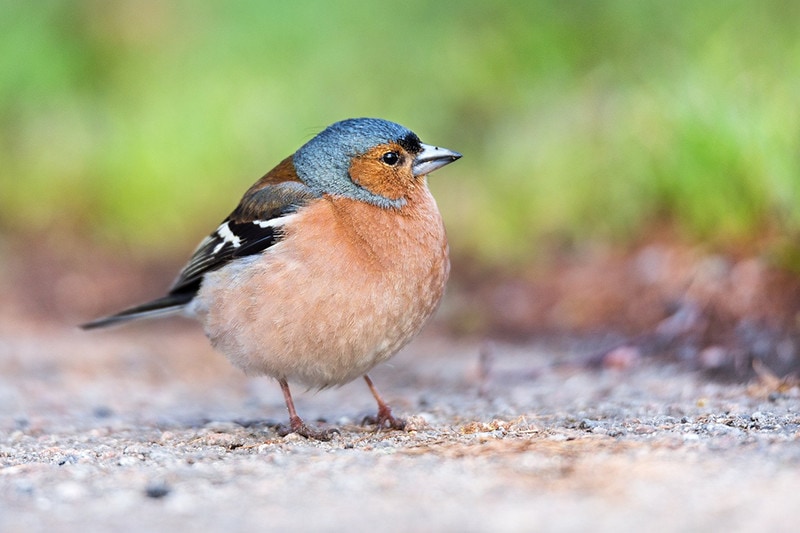
| Lifespan: | 5–10 years (with some species-specific exceptions) |
| Diet: | Seeds, fruits, vegetables, and insects |
Finches are small birds that come in a wide variety of colors. There are actually many different types of Finches, and all of them have slightly different characteristics. They have differing beak shapes depending on what they’re consuming. For instance, some have thin, pointed beaks to feed on insects, while others have rounded beaks to crack open seeds.
Most Finches primarily eat seeds. Therefore, they need a similar diet in captivity. They may also benefit from fresh fruits and veggies, which can provide some extra nutrients. Insect protein can be added as your bird needs.
Finches are social birds. Therefore, it’s important to keep them in pairs or small groups. They don’t necessarily do great by themselves and they shouldn’t be kept alone for long periods. They also require larger cages, as they tend to be pretty active. Because of these factors, they can actually take up a lot of room.
On top of a spacious cage to fly around in, Finches also benefit from exercise outside of the cage. Beyond that, their care requirements are similar to other birds.
3. Budgies
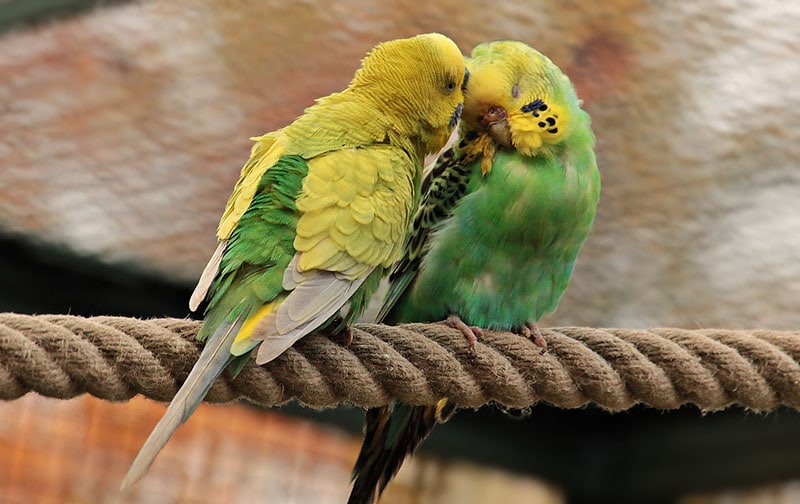
| Lifespan: | 5–10 years |
| Diet: | Seeds, grains, fruits, vegetables |
Budgies are native to Australia and are a type of small parrot. They’re known for their bright coloration and happy personalities, which may be why they are so popular.
They usually grow to around 7 to 8 inches. There are many different colors available, ranging from the typical green to blue, white, and grey. Males and females can often be distinguished by the colors of their beaks, which makes them one of the easiest birds to sex.
They eat a diet of grains, fruits, and vegetables. Many owners feed them seeds, however, this isn’t necessarily the best option. They can be exceptionally picky birds, so they often only eat what they’ve eaten in the past. Many also benefit from fresh produce, such as carrots, apples, and leafy greens.
These birds are social animals. Therefore, they do best in small groups. They can be fine by themselves if they are regularly handled by their human caretaker. However, those with less time should plan on adopting two at least.
Budgies are active and need a spacious cage to move around in. They also benefit from being let out of their cage regularly for exercise.
- Related Read: Can Cockatiels and Budgies Live Together?
4. Lovebirds
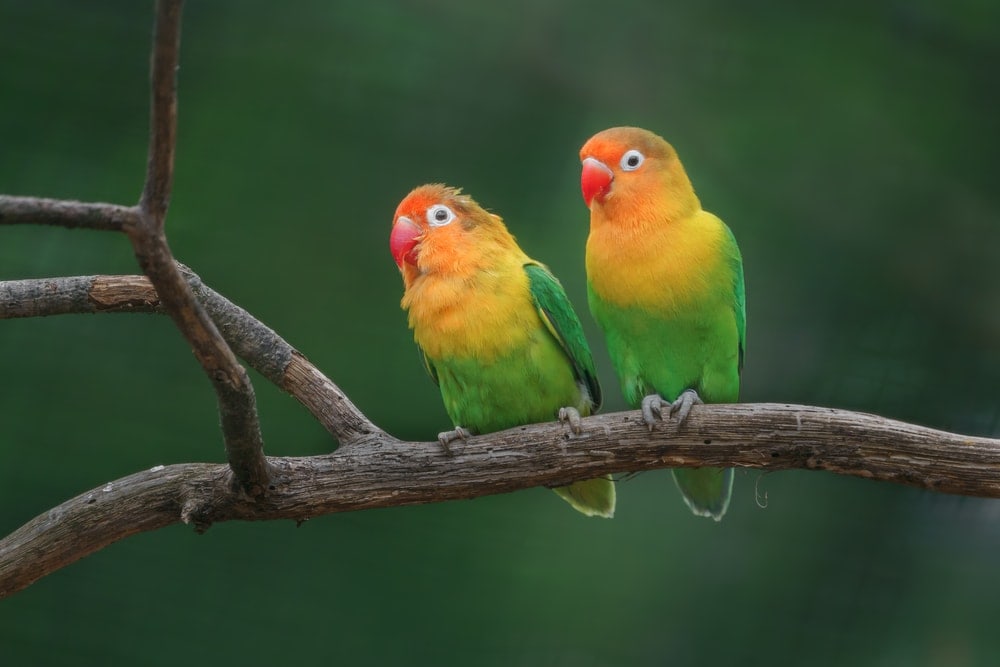
| Lifespan: | 10–15 years |
| Diet: | Grains, seeds, fruits, and veggies |
Lovebirds are small, social parrots that are native to Africa. They’re extremely popular because of their affectionate behavior—hence their name. They usually only grow between 5 and 7 inches, and they have a rather stocky build. They can be found in many different colors, ranging from blue to yellow. They also have distinctive markings around their eyes in most cases.
As highly social birds, they do best when kept in pairs. They’re extremely affectionate towards their mates, though they can form close bonds with birds of the same species and their owners.
They’re active birds, so they need a rather large cage. They’re very curious, so a range of toys is recommended. They’re very vocal and able to mimic some sounds. Lovebirds tend to chirp and whistle around the clock, so they aren’t a good option for anyone looking for a quieter bird.
5. Parrotlets
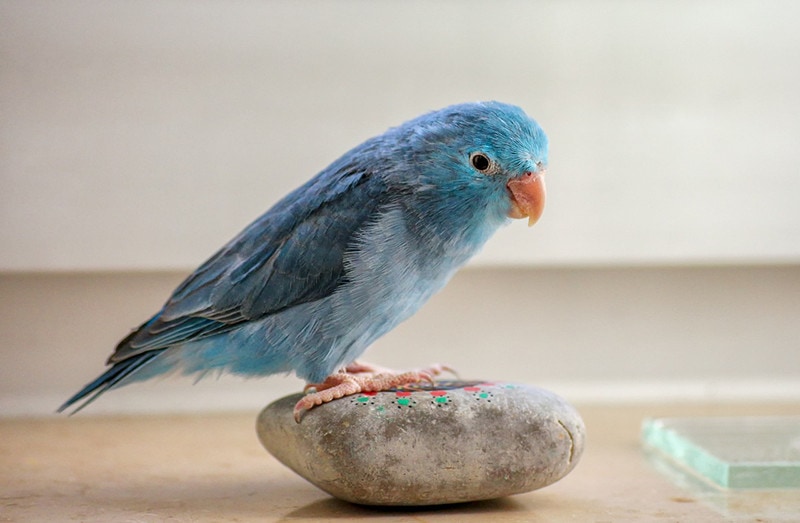
| Lifespan: | 10–15 years |
| Diet: | Grains, fruits, and vegetables |
Parrotlets are basically smaller parrots, hence their name. They’re very popular because of their intelligence and playful demeanor. They’re very small birds, growing no larger than 5 inches. You can find them in several color variations, ranging from blue to white. Their beak is rather large in comparison to their body size.
Like most of the birds on this list, Parrotlets are very social birds that prefer to be kept in small groups. They’re playful and very active. Therefore, they do best in larger cages. They take up a bit more room than other small birds for this reason.
These birds can form close bonds with their humans. They’re bold and often intelligent enough to be trained. They’re quite vocal, as well, so they may mimic sounds. We don’t recommend them to those looking for quieter birds.
They live longer than most birds on this list, maxing out at around 20 years with proper care. However, some of them may only live to 10 years, usually due to the poor living conditions many experience in captivity.
6. Cockatiels
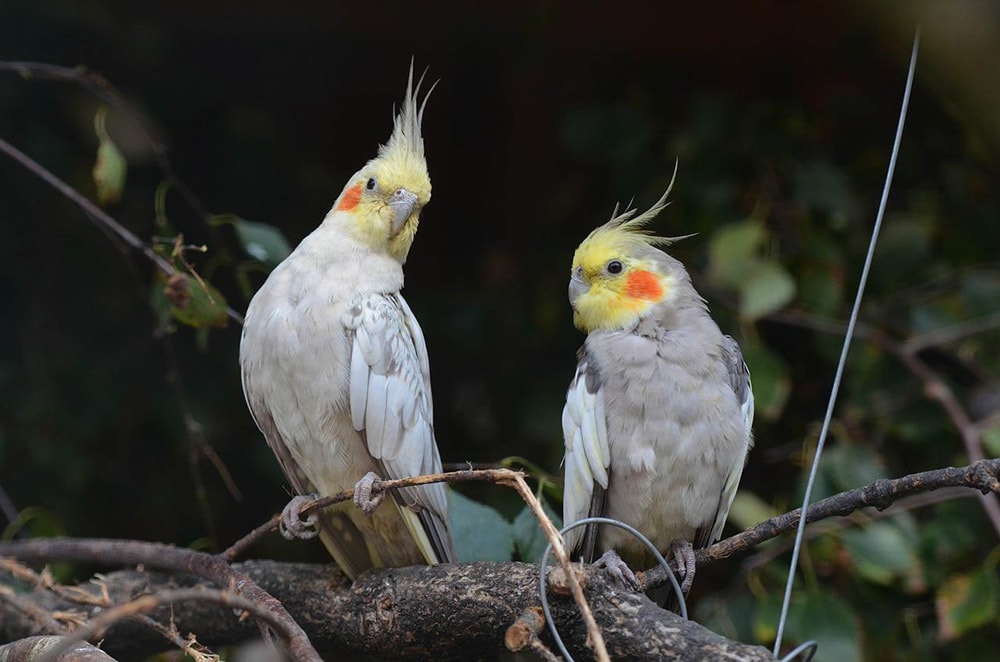
| Lifespan: | 10–20 years |
| Diet: | Grains, seeds, fruits, and vegetables |
If you’re interested in birds, you’ve probably heard of a Cockatiel. These small birds are native to Australia and are easily one of the most popular pet birds in the world.
These birds grow to be a bit larger than others on this list, sometimes reaching up to 14 inches. They have long, slender tails and a crest on their heads. You can get them in many different colors, though they aren’t necessarily as bright as some other species.
They’re very social animals. Therefore, they do best when kept in small groups. They’re very affectionate towards their owners, though, so they can sometimes be kept without another parrot if they are regularly interacted with. They may even preen and cuddle their owner in some cases.
They have similar care requirements to other birds. They need plenty of room to move around and do best with a larger cage due to their larger size. They’re vocal and can perform a variety of different tricks. They may even mimic sounds in some cases.
These birds can live up to 25 years. However, they may live as short as 10 if they aren’t cared for properly.
7. Conure
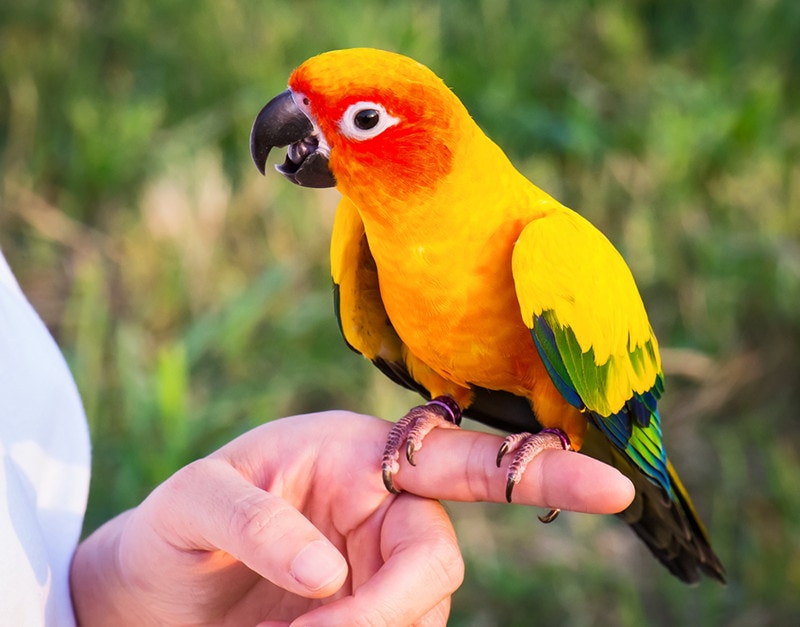
| Lifespan: | 20–30 years |
| Diet: | Seeds, grains, fruits, and vegetables |
Conures are native to Central and South America. However, they’re also very popular pets due to their intelligence and playful personalities. They’re fun birds to own, making them great for those that want a bit more hands-on species. They come in many different colors, including blue, yellow, and red. The brighter the color, the more expensive the bird tends to be. Some color variants are particularly expensive.
Their body is medium-sized and their long, tapered tails and distinctive beak set them apart from other species.
These birds are extremely social. They either need to be kept in pairs or kept by a human that will socialize with them regularly. They can mimic sounds and tend to be more intelligent than other birds out there. Therefore, they tend to be quite popular, though also more work.
Conures are playful and affectionate and they often love to preen their owners. Once domesticated, they can make great pets.
Conclusion
Whatever bird you choose, it’s important to care for them properly. Sadly, many domestic birds aren’t cared for well, usually because their owner just doesn’t know how. Birds often require a larger cage than owners tend to expect. While smaller cages are available at many pet stores, they often aren’t suitable for many birds.
Many small birds can live on seeds. However, this usually isn’t the best diet. It can be high in fat and low in nutrients. Sometimes, health problems can pop up later in the bird’s life due to their primarily seed-based diet. Instead, many birds do best on a pellet diet, which can contain more nutrients. Of course, getting picky birds switched over to a pellet diet can be challenging.
See also:
- 8 Amazing Talking Pet Birds You Can Bring Home Today
- 12 Cheapest Pet Birds: The Most Affordable Species
- 3 Birds That Don’t Fly That You Can Keep as Pets
Featured Image Credit: Andreas Lischka, Pixabay



